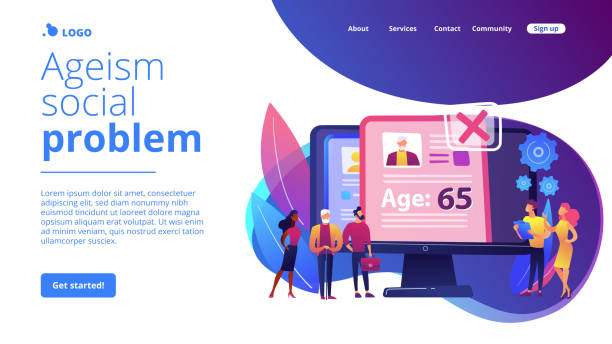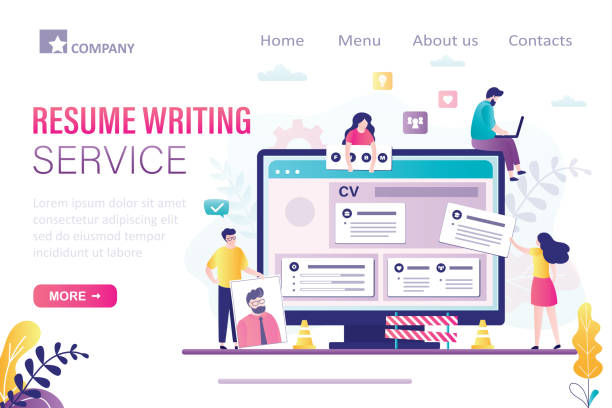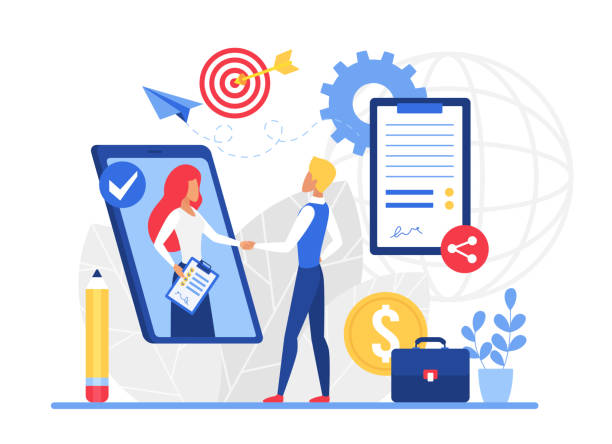The Unparalleled Importance of Fast Website Design in Today’s World

In the current digital age, website speed is not just an advantage, but an absolute necessity.
Fast website design means creating a seamless user experience that attracts and retains visitors.
Studies show that even a few milliseconds delay in page loading can lead to user loss and decreased conversion rates.
This is particularly crucial for online businesses, as every second of delay can mean losing potential customers and reducing revenue.
The importance of #website loading speed is not limited to user experience.
Search engines like Google also place great importance on site speed, considering it a key factor in search result rankings.
Therefore, a slow website can lower your search ranking and severely impact your visibility.
It’s an undeniable truth that #high-speed website design is the foundation of online success in the online space.
From an explanatory perspective, we will show you why investing in fast website design not only yields significant return on investment but also greatly aids your branding and online credibility.
Furthermore, with the increasing use of mobile devices to access the internet, optimizing speed for mobile is also of particular importance.
Mobile users expect web pages to load quickly and without any delay.
Ignoring this aspect can lead to losing a large portion of your mobile audience.
Therefore, every step you take to optimize site speed not only improves user experience but also aids SEO and ultimately your business success.
The discussion about the #importance of speed in websites is also a news topic, as search engine algorithms are updated daily, and speed has always been a significant factor in these updates.
In fact, building a high-speed website is no longer a luxury option but an indispensable part of a successful digital marketing strategy.
Many businesses have only recently realized that neglecting speed can lead to disastrous financial outcomes.
Do you know that customers’ first impression of your company is your website? Multiply your business’s credibility with a powerful corporate website from Rasawww!
✅ Custom and eye-catching design tailored to your brand
✅ Improved user experience and increased customer acquisition
⚡ Get a free consultation!
Key Factors Slowing Down Website Speed

To achieve fast website design, we must first identify the main factors that cause website slowness.
Often, problems arise from neglecting small details that collectively have a big impact on site performance.
#High-volume images are one of the most common reasons for slow websites.
Users often upload large, high-quality images directly to the site without optimization, which significantly increases loading time.
In addition to images, extra and unused code also plays a significant role in reducing speed.
CSS, JavaScript, and HTML codes that are not properly compressed or contain unnecessary sections not used by the site can increase loading time.
#Heavy scripts and numerous plugins, especially in content management systems like WordPress, can heavily burden the server and lead to reduced speed.
This is an analytical issue that needs careful examination.
Poor web hosting is also a critical factor.
Choosing a cheap or shared hosting with limited resources can severely reduce your site’s speed, even if you’ve done the best client-side optimizations.
#Unoptimized databases and frequent server requests can also create bottlenecks that lead to slowness.
From an educational perspective, understanding these factors is essential for anyone aiming for fast website design.
Finally, the lack of using a Content Delivery Network (CDN) for international users can also lead to slowness, as content must be delivered from the main server, which might be thousands of kilometers away.
Accurately identifying and addressing these factors is the first step towards increasing website speed.
These points will help you better understand the challenges on the path to fast website design.
Technical Optimization Techniques for Increasing Loading Speed

Achieving fast website design requires employing a set of advanced technical techniques.
One of the most important of these techniques is #image optimization.
This includes compressing images without noticeable quality loss, using appropriate formats (like WebP), and Lazy Loading.
With these methods, image sizes are minimized, and images are loaded only when the user needs them.
Caching is another very effective solution.
By using caching, your website’s information is stored in users’ browsers for subsequent visits.
This means that on subsequent visits, there’s no need to reload all content from the server, and loading speed significantly increases.
This approach is particularly crucial for fast website development.
Minification of code involves removing white spaces, comments, and unnecessary code from HTML, CSS, and JavaScript files.
This reduces file sizes and shortens their transfer time from the server to the user’s browser.
This is a specialized technique that requires high precision.
Using Gzip compression on the server can also significantly reduce the volume of data sent.
The server compresses files before sending them, and the user’s browser decompresses them.
This process leads to increased website speed.
Our guidance in this section for achieving fast website design is not to forget font optimization.
Using optimized web font formats like WOFF2 and loading fonts asynchronously can prevent slow initial page loading.
These are all important steps on the path to fast website design.
| Technique | Description | Impact on Speed |
|---|---|---|
| Image Optimization | Compression, changing format to WebP, Lazy Loading | Very High |
| Caching | Storing content in user’s browser | High |
| Minification of Code | Removing white spaces and extra code from HTML, CSS, JS | Medium |
| Gzip Compression | Compressing data sent from the server | High |
| Font Optimization | Using optimized formats and Asynchronous loading | Medium |
The Role of Server and Hosting in Unparalleled Website Speed

In addition to client-side optimizations, #choosing the right server and hosting plays a vital role in achieving fast website design.
Even if your website uses optimized code and compressed images, a weak server infrastructure can negate all your efforts.
Cheap shared hosting might be suitable for starters, but they usually lack sufficient resources to handle high traffic and can lead to website slowness.
For a fast and stable website design, Dedicated Servers, Virtual Private Servers (VPS), or Cloud Hosting are much better options.
These services provide more resources and can handle higher volumes of traffic and requests.
#Using servers with SSD disks instead of HDDs can also significantly increase data access speed.
This is a technical point that receives less attention.
Content Delivery Network (CDN) is also a powerful tool for increasing website speed.
CDN stores your website’s static content (such as images, CSS, and JavaScript) on multiple servers in different geographical locations.
When a user visits your website, the content is delivered from the closest CDN server to them, which reduces physical distance and minimizes loading time.
This is a very practical guideline for websites with a global audience.
Also, ensure that your server uses the latest versions of server software like PHP and MySQL.
Updating these software can create significant improvements in performance and security.
Choosing a host with strong technical support and 24/7 monitoring is also very important for fast web design process and its maintenance.
These are all parts of a comprehensive strategy for fast website design.
How much does losing business leads due to an unprofessional website cost you? Solve this problem forever with professional corporate website design by Rasawww!
✅ Increase credibility and trust among potential customers
✅ Easier acquisition of new business leads
⚡ Get a free consultation now!
Code Quality and Framework Selection for Fast Design

Code quality and the correct selection of frameworks or Content Management Systems (CMS) are considered fundamental to fast website design.
Clean, optimized code without unnecessary sections not only ensures faster page loading but also simplifies future website maintenance and development.
#Standard coding and adherence to best practices in HTML, CSS, and JavaScript are of high importance.
In the realm of CMSs, #WordPress, Joomla, and Drupal are popular choices.
However, it must be remembered that these systems themselves can lead to slowness if not properly optimized.
Using lightweight themes and minimal, essential plugins plays a significant role in maintaining speed.
Many speed issues in WordPress websites stem from installing too many low-quality plugins.
This part of our discussion is an important educational point for developers.
For larger and custom projects, using modern frameworks like React, Angular, Vue.js on the frontend and Laravel, Django, Ruby on Rails on the backend can contribute to fast and scalable website development.
These frameworks provide optimized tools and design patterns, allowing developers to write more efficient code and minimize speed-related complexities.
This is a specialized perspective for fast web design.
Database optimization is also an inseparable part of code quality.
Ensuring that queries are optimized and appropriate indexes exist for database tables can significantly increase data retrieval speed.
Neglecting this can lead to inexplicable slowness in loading pages with large amounts of information.
All of these are steps towards building a high-speed website.
Ultimately, continuous education and keeping technical knowledge up-to-date in the field of fast website design are essential.
The Impact of Site Speed on User Experience and Conversion Rate

Beyond technical considerations, fast website design directly impacts User Experience (UX) and ultimately the Conversion Rate.
In today’s world, where users have quick access to information, no one wants to wait for a web page to load.
#Slow websites can frustrate users and lead them to abandon your website and visit your competitors.
This is an important analytical reality.
A smooth and fast user experience #builds user trust and encourages them to spend more time on your website, view more pages, and ultimately take your desired action (such as making a purchase, signing up, or filling out a form).
Conversely, slow websites can quickly lead to lost business opportunities and reduced revenue.
Have you ever considered how much one second of loading delay can harm your business? This is a thought-provoking content that should be taken seriously.
Also, site speed affects your brand popularity.
A fast and responsive website appears more professional and trustworthy.
This positive perception can help strengthen your brand in users’ minds.
For fast web design process, these psychological and business aspects should be considered from the outset.
Finally, search engines also consider user experience as an important ranking factor.
Faster websites typically have lower bounce rates and higher dwell times, which send positive signals to search engines and can help improve SEO rankings.
Therefore, every step towards fast website design is, in fact, an investment in the long-term success of your online business.
The importance of site speed optimization is clearly demonstrated here.
Introducing Essential Tools for Website Speed Assessment

To ensure you are on track with fast website design and have achieved your goals, you need to use speed assessment tools.
These tools help you identify your website’s weaknesses and find suitable solutions for improvement.
#Google PageSpeed Insights is one of the most popular and important of these tools, provided by Google itself.
This tool gives a score from 0 to 100 for your website’s speed in both desktop and mobile modes and offers suggestions for speed improvement.
GTmetrix is another tool that provides very comprehensive reports on your website’s performance.
This tool supports Google’s Core Web Vitals and gives you precise details about loading time, network requests, and optimization suggestions.
Additionally, you can examine your site’s performance in different geographical locations, which is very useful for increasing website speed on a global scale.
This is a very powerful guidance tool.
WebPageTest is a more advanced tool for website speed analysis.
This tool allows you to perform custom tests with different browsers, varying internet speeds, and from various geographical locations.
This information is very valuable for fast and accurate website development.
#Lighthouse, also available internally in Chrome browser, is an open-source audit tool that, in addition to speed, addresses other metrics such as accessibility, best practices, and SEO.
These tools provide you with an educational and comprehensive view.
Regular use of these tools and continuous monitoring of website speed are a vital part of the fast website design strategy.
This helps you always ensure your site’s optimal performance and quickly identify and resolve any issues.
Do not forget that the ultimate goal of fast website design is to provide the best user experience and improve search engine rankings.
| Tool | Strengths | Key Features |
|---|---|---|
| Google PageSpeed Insights | Integration with Google search engine, Google’s recommendations | Scoring 0-100, optimization suggestions, mobile and desktop breakdown |
| GTmetrix | Comprehensive reports, Core Web Vitals support | Full loading time, network requests, weaknesses, various test regions |
| WebPageTest | Deep analysis and high customization | Tests from different locations and browsers, page load video, Waterfall chart |
| Lighthouse (Chrome DevTools) | Open-source and browser-integrated tool | Performance audit, accessibility, SEO, best practices |
Common Mistakes and How to Avoid Them in Fast Design

On the path to achieving fast website design, many developers and website owners make common mistakes that can negate their efforts.
#Ignoring image optimization is one of the biggest of these mistakes.
Often, high-volume images are uploaded without proper compression, which severely impacts site speed.
A key guideline is to always optimize images before uploading them.
Another common mistake is the excessive use of plugins and extra scripts, especially in CMSs like WordPress.
Every plugin you install adds code to your site that can lead to slowness.
Before installing any plugin, ensure you truly need it and check its performance.
This is a thought-provoking content that should always be kept in mind.
Choosing inappropriate hosting is also a glaring error.
Some, to save costs, choose low-quality shared hosting, which can severely impact overall site performance.
Investing in quality hosting that suits your website’s needs is an essential step for increasing website speed.
Not using caching and CDN is also a common mistake.
These techniques have a significant impact on loading speed, and ignoring them can mean missing out on great opportunities for performance improvement.
From an explanatory perspective, every website, small or large, can benefit from these tools.
Finally, neglecting mobile optimization is also a major mistake.
Given the increase in mobile traffic, ensuring your website loads quickly on mobile devices is essential for fast website design and success in the current era.
To build a high-speed website, all these mistakes must be avoided.
Do you know that a weak corporate website costs you many opportunities daily? Solve this problem forever with professional corporate website design by Rasawww!
✅ Create a powerful and reliable image of your brand
✅ Targeted acquisition of new customers and increased sales
⚡ [Get Free Website Design Consultation]
Continuous Maintenance and Monitoring to Preserve Site Speed

After achieving fast website design, the work doesn’t end; it just begins.
To maintain optimal website speed and performance in the long run, you need continuous maintenance and monitoring.
Websites are living entities that, over time, with the addition of new content, plugin updates, and changes in traffic, may lose their initial speed.
One of the most important aspects of maintenance is #regular updates of the Content Management System (CMS), themes, and plugins.
Developers constantly release new versions that include performance improvements, bug fixes, and security enhancements.
Ignoring these updates can lead not only to slowness but also to security vulnerabilities.
This is a vital guideline for all websites.
#Continuous monitoring of website speed using previously introduced tools (such as Google PageSpeed Insights and GTmetrix) is crucial for early detection of speed issues.
By setting up alerts, you can be notified as soon as site speed drops and take necessary actions.
This is a specialized approach to maintaining increased website speed.
Periodic database review and optimization are also of high importance.
Over time, the database can become filled with extra and unnecessary information, leading to slow performance.
Regular database cleaning and optimization can have a positive impact on your site’s overall speed.
This section is very important for fast website design that requires stability over time.
Content management and removal of extra files are also part of maintenance.
Old images, unused media files, and outdated cache files can occupy server space and affect performance.
By observing these points, you can ensure that your website is always available to users with the highest speed and best performance, and achieve the goals of fast website development.
The Future of the Web and the Necessity of Faster Website Design

The future of the web is increasingly moving towards greater speed and efficiency.
With technological advancements and rising user expectations, fast website design will not only be a standard but an undeniable necessity.
#Emerging technologies like WebAssembly, HTTP/3, and Edge Computing are changing the web speed landscape and providing new potentials for instantaneous page loading.
This is an exciting news perspective.
WebAssembly allows developers to execute high-performance code directly in the browser, which can help run more complex and heavy web applications at high speeds.
HTTP/3 is the new generation of the HTTP protocol, built on the QUIC protocol, and significantly improves page loading speed by reducing latency and increasing efficiency.
These are all effective factors in increasing website speed.
Edge Computing is also a new paradigm that moves data processing closer to the user instead of a central server.
This means reduced latency and increased website responsiveness, especially for dynamic content and complex web applications.
These perspectives show us that building a high-speed website will be even more crucial in the future than it is today.
With the advent of Virtual Reality (VR) and Augmented Reality (AR) on the web, the need for unprecedented speeds to deliver rich and lag-free experiences will increase.
Websites unable to provide these experiences at high speeds will quickly become obsolete.
Therefore, awareness of these trends and preparation of the necessary infrastructure for fast and future-proof website design is essential for every business and developer.
This is also an entertaining topic that shows how far web technology boundaries will expand.
Frequently Asked Questions
| No. | Question | Answer |
|---|---|---|
| 1 | What is the concept of “fast website design”? | Designing a website that loads in the shortest possible time and provides a smooth user experience, with an emphasis on performance optimization. |
| 2 | Why is site loading speed important for users? | Today’s users have little patience; slow websites lead to premature page abandonment, poor user experience, and loss of visitors. |
| 3 | How does fast website design affect SEO? | Search engines like Google consider site speed a ranking factor. Faster websites achieve better rankings in search results. |
| 4 | What are the main factors affecting site speed? | Image optimization, caching, CSS and JS file compression, using powerful hosting, reducing HTTP requests, and optimized coding. |
| 5 | How can website loading speed be measured? | By using tools like Google PageSpeed Insights, GTmetrix, Lighthouse, and Pingdom Tools, which provide accurate reports on site performance. |
| 6 | What is the role of images in site speed and how should they be optimized? | High-volume images can severely reduce site speed. They should be compressed, modern formats (like WebP) should be used, and Lazy Load technique should be employed. |
| 7 | What is the importance of choosing suitable hosting in fast website design? | Powerful and high-speed hosting (preferably SSD) with optimized servers close to target users is the foundation of a website’s speed. |
| 8 | How does Caching help increase site speed? | Caching allows the user’s browser to store copies of site files, so on subsequent visits, there is no need to reload all content, and the site is displayed faster. |
| 9 | Is using a CDN (Content Delivery Network) recommended in fast website design? | Yes, CDN significantly increases loading speed by storing copies of site content on various geographical servers and delivering it from the closest server to the user. |
| 10 | What are the key tips for developers to design a high-speed website? | Writing clean and optimized code, minimal use of plugins, optimizing database queries, using lightweight frameworks, and implementing Lazy Load for content. |
And other services of Rasa Web Advertising Agency in the field of advertising
Smart Digital Advertising: Transform sales growth with the help of user experience customization.
Smart Website Development: A fast and efficient solution for user interaction focusing on marketing automation.
Smart Content Strategy: A combination of creativity and technology to increase click-through rates through SEO-driven content strategy.
Smart Social Media: A creative platform to improve sales growth by precisely targeting the audience.
Smart Brand Identity: An effective tool for user engagement with the help of precise audience targeting.
And over hundreds of other services in the field of internet advertising, advertising consultation, and organizational solutions
Internet Advertising | Advertising Strategy | Advertorial
Sources
Website Speed OptimizationComprehensive SEO GuideFaradars Web Design TrainingBest Practices for Web Design
? At Rasawww Afarin, your dream of a powerful digital presence becomes a reality. By providing comprehensive digital marketing services, including fast website design and professional optimization, we elevate your business to its peak.
📍 Tehran, Mirdamad Street, Next to Central Bank, Kazeroon Jonubi Alley, Ramin Alley, No. 6

